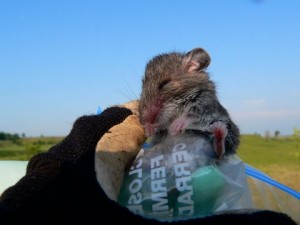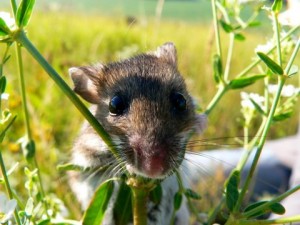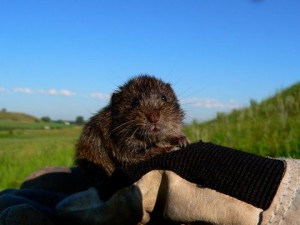Undergraduate research is a wonderful way for students to get out of the classroom and experience science first-hand. NC State University offers many resources for undergraduates interested in getting research experience. Among these are on-campus opportunities with NC State faculty, international resources, and the National Science Foundation Research Experience for Undergraduates (REU). Asia Murphy, a junior in the Fisheries, Wildlife, and Conservation Biology program at NC State and regular contributor to our blog, took advantage of the REU program and found a summer research program that kept her “hopping”. Here is Asia’s account of her summer research:
The Story of a Wildlife Student’s Summer Research Experience in Minnesota
– submitted by Asia Murphy
There was a flash of gray in the corner of my eye. It arced up into the sky and fell ten feet away into the wet, knee-high grass. I looked up from the clipboard where I had been writing that the critter we had caught was a bona-fide prairie vole and asked Dr. Angell, my mentor, “What was that?”
She looked at me sheepishly, wriggling gloved fingers. I noticed that the Ziploc bag that had been holding our prairie vole was now mysteriously empty. “That was the vole.”
It was the first time that I had seen a prairie vole fly. Luckily, it was also the last.
This summer I spent ten weeks in Northfield, Minnesota as a participant in an REU program held by St. Olaf College. My project was to study the dietary differences in small mammals in restored and remnant prairies using stable isotope analysis. I didn’t have too clear a picture of what my research would entail. I thought I would go walking into thin, short grass, catch docile mice, do something with them, and then at the end of ten weeks, there would be results. I think I received my first rude awakening our first trapping day. Dr. Angell got me up bright and early around six to drive out to her prairie and check traps. I battled exhaustion, uneven ground and poison ivy, watching her as she handled the animals we caught—mainly prairie deer mice—much like someone would handle Shake n’ Bake chicken.
After a couple of days of observation, I was able to handle the animals we caught with the same amount of ease. Shake them out of the trap, weigh, measure, sex, identify, take hair samples, release, repeat. I started to have fun, walking around in Dr. Angell’s beautiful prairie. It was a gorgeous remnant, with sandy soil that gently rose to a rocky bluff.
And then there were the restored prairies. The natural lands were owned by St. Olaf, just five minutes away from campus. It was a beautiful piece of land, complete with a pond. At sunset, it looked quite picturesque. But as a prairie, it left something to be desired, namely: plant diversity. It looked much like an overgrown lawn. We caught small numbers of meadow voles—a common species in restored prairies—and a short-tailed shrew. In addition to this, I had the summer’s first brush with my lifelong nemesis: ticks.
By the time we moved the field work to the Cowling Arboretum, I had become a professional at running the project. I taught my other mentor, Dr. Hernandez, how to trap and handle small mammals. Two of his students helped me. I soon grew used to waking early in the morning and baiting traps in the evening, the never-ending fear of finding ticks attached to me, and nearly spraining my ankles on each excursion. An unknown predator found out about our traps, and we began to find grizzly presents each morning.
Question: What does the head of a meadow vole + the back half of a meadow jumping mouse equal?
Answer: A meadow jumping vole.
 Throughout these bloody weeks, I began to grow eager to see my first prairie vole. Prairie voles are a species of special concern in Minnesota, and we never found them in restored prairies. Before, I had seen the research project as a task that I had to grind through and complete. But now I began to be driven by an actual desire to know why prairie voles weren’t in restored prairies. Was it because restored prairies were fundamentally different from remnant prairies? Or was it because of an unknown factor in the relationship between prairie voles and meadow voles, which could easily be found in restored prairies and were vicious little monsters in a cute teddy-bear package?
Throughout these bloody weeks, I began to grow eager to see my first prairie vole. Prairie voles are a species of special concern in Minnesota, and we never found them in restored prairies. Before, I had seen the research project as a task that I had to grind through and complete. But now I began to be driven by an actual desire to know why prairie voles weren’t in restored prairies. Was it because restored prairies were fundamentally different from remnant prairies? Or was it because of an unknown factor in the relationship between prairie voles and meadow voles, which could easily be found in restored prairies and were vicious little monsters in a cute teddy-bear package?
Then came McKnight site, another remnant prairie owned by Carleton College and our first prairie vole. I took tons of pictures of this elusive rodent, and Dr. Angell and I exclaimed over the grizzled fur, the difference in ear size, and the calmer nature. We were somewhat bemused to trap only three males on McKnight, but we took it as good news, as in the years past, they had only trapped two.
We returned back to Dr. Angell’s prairie and trapped on top of the bluff. We were excited to find two females and a male of the species. We talked about doing a little exchange program, bringing in a male from McKnight and switching him out for a female from Dr. Angell’s bluff. But summer was winding down, and lab work gained priority. After two intense days of sample preparation our data came back. Within a week, our poster was ready. The results were surprising. We found that prairie voles and meadow voles ate the same foods, even if they were in two different communities. Therein was the answer to my question. The problem wasn’t with the restoration of the prairies; the problem was in the relationship between meadow voles and prairie voles.
It was the end of summer, and I was ready to go home. I had research to add to my resume and a great relationship with my mentor to fall back on. I had also learned a couple of things. I learned that there were leeches up north, and that they could get enormous. I tasted organic ice cream and found it delicious, though perhaps not worth the price tag. I hated ticks with a passion born of fear and disgust. Field work was exhausting, unpredictable and dangerous to the accident-prone. It is also something that I love to do, and can’t wait to do again.

